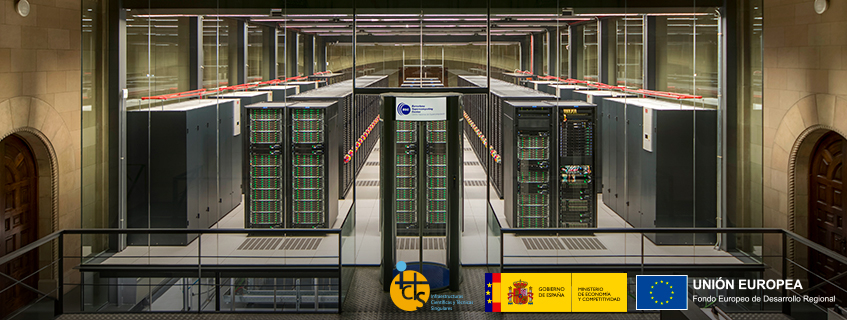
MareNostrum is the generic name that BSC uses to refer to the different updates made to its most emblematic supercomputer and the most powerful supercomputer in Spain. So far, five versions have been installed.
MareNostrum 1
In March 2004 the Spanish government and IBM signed an agreement to build one of the the fastest computers in Europe. Its computing capacity was 42.35 Teraflops (42.35 trillion operations per second).MareNostrum 2
In November 2006 its capacity was increased due to the large demand from scientific projects. MareNostrum increased its calculation capacity to 94.21 Teraflops, doubling its previous capacity. In order to achieve this, it increased its number of processors from 4.812 to 10.240.Marenostrum 3
With the upgrade of 2012-2013, MareNostrum achieved a peak performance of 1.1 Petaflops. It was made up of 48,896 Intel Sandy Bridge processors in 3,056 nodes, including 84 Xeon Phi 5110P in 42 nodes, with more than 115 TB of main memory and 2 PB of GPFS disk storage.
MareNostrum 4
At the end of June 2017 begun operating MareNostrum 4, which when fully installed will have a peak performance of 13.9 Petaflops.
Its calculation capacity is distributed in two completely different blocks: a general-purpose block and an emerging technologies block:
- The general-purpose block has 48 racks with 3,456 nodes. Each node has two Intel Xeon Platinum chips, each with 24 processors, amounting to a total of 165,888 processors and a main memory of 390 Terabytes.
Its peak power is 11.15 Petaflops, or what is the same, it is able to perform more than eleven thousand trillion operations per second, ten times more than the MareNostrum 3, which was installed between 2012 and 2013. Although its power is ten times greater than that of its predecessor, it only increases energy consumption by a 30% and now is of 1.3 MWatt-year. - The second element of MareNostrum 4 is formed of clusters of three different emerging technologies that will be added and updated as they become available. These are technologies currently being developed in the US and Japan to accelerate the arrival of the new generation of pre-exascale supercomputers.
- MN4 CTE-Power: this cluster consists of IBM POWER9 processors and NVIDIA Volta GPUs, which are the same components that IBM and NVIDIA will use for the Summit and Sierra supercomputers that the US Department of Energy has commissioned for the Oak Ridge and Lawrence Livermore National Laboratories. Computing power over 1.5 Petaflop/s.
- MN4 CTE-AMD: this cluster is made up of AMD Rome processors and AMD Radeon Instinct MI50. The machine will have a similar processor and accelerator than the Frontier supercomputer that will be installed on 2021 at ORNL. The computing power of the machine willl be 0.52 Petaflop/s.
- MN4 CTE-ARM: this cluster is formed of 64 bit ARMv8 processors in a prototype machine, using state-of-the-art technologies from the Japanese Post-K supercomputer. Computing power over 0.65 Petaflop/s.





MareNostrum 4 has a disk storage capacity of 14 Petabytes and is connected to the Big Data infrastructures of BSC-CNS, which have a total capacity of 24.6 Petabytes. A high-speed Omnipath network connects all the components in the supercomputer to one another. Like its predecessors, MareNostrum 4 is also connected to the European research centres and universities through the RedIris and Geant networks.
MareNostrum is managed by the BSC Operations Department, which takes care of its availability, security and performance. An important task of this team is to support scientists in the usage of MareNostrum, as well as to help them to improve their applications to get better research results. They are also in charge of carrying out the updates of the machine.
A tool of great value for science
MareNostrum is entirely aimed at generating scientific knowledge. It is used in almost all scientific disciplines -from astrophysics and materials physics to biomedicine- and in engineering and industry.
MareNostrum 4 is used for research projects on climate change, gravitational waves, a vaccination against AIDS, new radiation treatments to fight cancer and simulations relating to the production of fusion energy, among others.
The MareNostrum 4 supercomputer is designated as a Special Scientific/Technical Infrastructure Facility by the Spanish Ministry of Economy, Industry and Competitiveness and is part of the PRACE Resarch Infrastructure as one of the 7 Tier-0 Systems currently available for European scientists.
Access to MareNostrum is possible through either Spanish Supercomputing Network RES or European programme PRACE.
These resources and expertise are not just available remotely. Both Spanish and European scientists can visit BSC-CNS through the available mobility programmes in order to work with our experts in supercomputing and learn more about how to improve their work and research results.
Barcelona Supercomputing Center manages MareNostrum 4 co-funded by the European Regional Development Fund (ERDF) through the Programa Operativo Crecimiento Inteligente FEDER 2014-2020.

BSC has other HPC resources available: Active Archive



